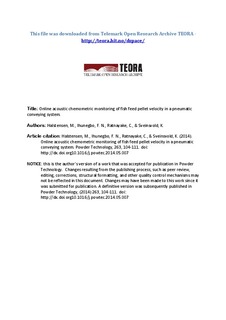| dc.contributor.author | Halstensen, Maths | |
| dc.contributor.author | Ihunegbo, Felicia Nkem | |
| dc.contributor.author | Ratnayake, Chandana | |
| dc.contributor.author | Sveinsvold, Karl | |
| dc.date.accessioned | 2015-02-27T13:51:00Z | |
| dc.date.accessioned | 2017-04-19T12:50:03Z | |
| dc.date.available | 2015-02-27T13:51:00Z | |
| dc.date.available | 2017-04-19T12:50:03Z | |
| dc.date.issued | 2014-03-14 | |
| dc.identifier.citation | Halstensen, M., Ihunegbo, F. N., Ratnayake, C., & Sveinsvold, K. (2014). Online acoustic chemometric monitoring of fish feed pellet velocity in a pneumatic conveying system. Powder Technology, 263, 104-111. | |
| dc.identifier.issn | 1650-3740 | |
| dc.identifier.uri | http://hdl.handle.net/11250/2438449 | |
| dc.description.abstract | Fish farmers consider the cost of fish feed pellets as one of the most expensive factors in fish cultivation. Proper control of the handling and conveying systems is necessary to avoid damage and disintegration of the cylindrically shaped fish feed pellets. Pneumatic conveying is widely used to transport large quantities of fish feed. Proneness of crushing the fish feed pellets caused by pellets interaction with the inner wall of the pipeline is a major concern to the manufacturer due to the associated economic loss; pellet damage increases exponentially with the conveying air velocity. On the other hand, too low conveying rates would lead to pipeline blockages and severe pipe vibration. In order to address the foregoing issues, it is necessary to optimize the conveying velocity of fish feed pellets during pneumatic transport. Application of an on-line monitoring technique based on non-invasive passive acoustic measurements and multivariate regression modeling (acoustic chemometrics) was investigated. A partial least squares regression (PLS-R) model was calibrated to predict pellet velocity from 19 m/s to 36 m/s in a pilot scale pneumatic conveying system. The PLS-R prediction model was validated based on independent experimental data (test set validation). The root mean square error of prediction (RMSEP), slope and r2 of the prediction results were 0.64 m/s, 1.02 and 0.97 respectively. The prediction results obtained shows the applicability of acoustic chemometrics for real-time prediction of the velocities of fish feed pellets during pneumatic conveying. | |
| dc.language.iso | eng | |
| dc.publisher | Elsevier | |
| dc.subject | Acoustic chemometrics | |
| dc.subject | partial least squares regression (PLS-R) | |
| dc.subject | Process analytical technology (PAT) | |
| dc.subject | fish feed pellets | |
| dc.subject | pneumatic conveying | |
| dc.subject | optimization | |
| dc.title | Online acoustic chemometric monitoring of fish feed pellet velocity in a pneumatic conveying system | |
| dc.type | Journal article | |
| dc.type | Peer reviewed | |
| dc.description.version | Accepted version | |
| dc.subject.nsi | 560 | |
| dc.identifier.doi | 10.1016/j.powtec.2014.05.007 | |
